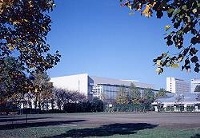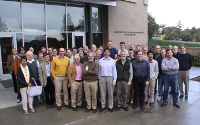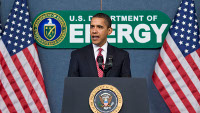 |
|
|
 |
Physics and detectors at TILC09
This month's Research Director's Report was written by Hitoshi Yamamoto, co-chair of the Worldwide Study and regional detector contact for Asia.

Conference venue for TILC09: Epochal Tsukuba |
I am writing this column for the first time as one of the three regional contacts who serve under the ILC research director Sakue Yamada, but also as a co-chair of World Wide Study (WWS) and a member of the Asian Committee for Future Accelerators (ACFA. There will be a joint ACFA Physics and Detector Workshop and GDE Meeting (TILC09 – where 'T' stands for Tsukuba) from 17 to 21 April. The venue is a conference centre called EPOCHAL Tsukuba located in the central part of the city of Tsukuba. In 1985, an international exhibition was also held around this location, and KEK is about 10 kilometres to the north. In this note, let us focus on the physics and detector part of the workshop since the accelerator part has been covered in the Director's Corner of February 19.
Read more...
-- Hitoshi Yamamoto
Research Director's Report Archive |
 |
|
|
 |
Fermilab experiments constrain Higgs mass

Scientists from the CDF and DZero collaborations combined Tevatron data from their two experiments to increase the sensitivity for their search for the Higgs boson. While no Higgs boson has been found yet, the results announced today exclude a mass for the Higgs between 160 and 170 GeV/c≤ with 95 percent probability. Image: Fermilab.
Read the press release |
|
 |
Life after the LOI
SiD Workshop at SLAC

SiD workshop participants taking a break from discussion the LOI. (Photo: Norman Graf) |
A Silicon Detector (SiD) workshop was held at SLAC from 2 to 4 March, with the express purpose of reviewing the status of the SiD Letter of Intent, organising the final steps in its completion, and beginning to think of life after the LOI.
Persis Drell, the SLAC Director, opened the meeting by welcoming the collaboration to SLAC, and restated her firm conviction that the science case for the linear collider was as strong as ever. She noted shortcomings in the present US strategy to realise the ILC, and committed to working with others towards a remedy. Barry Barish followed Persis with a review of the Global Design Effort's considerable technical progress and a renewed commitment to be ready with a strong proposal to funding agencies in 2012.
Read more...
-- Tom Markiewicz, SLAC |
 |
|
|
 |
From Nature
19 March 2009
Editorial: Filling the void
As science journalism declines, scientists must rise up and reach out.
Read more... |
|
From Interactions
18 March 2009
Particle oddball surprises CDF physicists at Fermilab
Batavia, Ill.--Scientists of the CDF experiment at the Department of Energy's Fermi National Accelerator Laboratory announced yesterday (March 17) that they have found evidence of an unexpected particle whose curious characteristics may reveal new ways that quarks can combine to form matter.
Read more... |
|
From Symmetry Breaking
16 March 2009
SuperB moves forward
A proposal for this next-generation machine is already well underway, and the projectís 150 international collaborators – including many current and former BaBar scientists – plan to present it to the Italian government later this year
Read more... |
|
From Interactions.org
13 March 2009
Fermilab experiments constrain Higgs mass
To increase their chances of finding the Higgs boson, the CDF and DZero scientists combine the results from their separate analyses, effectively doubling the data available.
Read more... |
|
From AFP
13 March 2009
Launch of 'big bang' satellites delayed
The launch of two European scientific telescopes Herschel et Planck designed to probe the secrets of the Universe, which was planned on 16 April, is postponed by several weeks.
Read more (in French)... |
|
From Interactions.org
13 March 2009
CERN celebrates 20th anniversary of World Wide Web
I'm pleased to say that the spirit of innovation that allowed Tim Berners-Lee to invent the Web at CERN, and allowed CERN to nurture it, is alive and well today.
Read more... |
|
From BBC
12 March 2009
EU needs 'brutal' science advice
... In Europe, the body that provides scientific support to the commission is the Joint Research Centre, which Professor Beddington describes as "excellent". But it was unable to provide the proactive and sometimes "brutal" scientific advice that policy makers might not want to hear, he told BBC News.
Read more... |
|
From New Scientist
11 March 2009
Europe plays catch-up to Obama's science drive
This deserves celebration, but it should also serve as a wake-up call to the European Union.
Read more... |
|
|
 |
 |
|
|
 |
Science in the Obama era

President Barack Obama speaks at US Department of Energy (February 2009). Photo: Whitehouse.gov |
“We will restore science to its rightful place,” said President Barack Obama in his inauguration address. That statement has raised the hopes of the scientific community, and actions that have followed have further encouraged us to believe that we are entering a new era in the US that will have increased priority for the support of science. On the other hand, the most important problem in the US and worldwide is to deal with the deep economic downturn and the early actions by the new administration are dominantly aimed at dealing with this economic crisis and include a very large stimulus bill. In addition to economic stimulus, early decisions by the Obama administration have included appointing a number of highly regarded scientists to key high-level government positions. It is worthwhile anticipating how all the changes will impact US science, high-energy physics, in particular, and finally on our efforts towards the ILC.
Read more...
-- Barry Barish
Director's Corner Archive |
 |
|
|
 |
Correction
Last week's feature on electron cloud work done at CERN caused confusion over the spacing of the beam screens and the spacing of the screens' sawteeth. The original text wrongly stated that the "beam screens protecting the superconducting magnets along the path of the beam every 300 micrometres, for example, have teeth (or grooves) that stop the photons, suppress photon reflections, and thus stop electrons getting knocked out above or below the beam." In fact it's the 30-micrometer teeth that are spaced at 500 micrometres from each other on every screen. These screens, installed in the 80 percent of the LHC that are cold (heat load being less of an issue in the 20 percent of the ring that are warm), uniformly cover the entire inner surface along the cold LHC arcs. ILC NewsLine apologises for any cloudiness this may have caused.
arXiv preprints
0903.2366
Frequency of Positron Helicity Reversal
EUROTeV Reports
2008-022
Beam Dynamics Using the Stream Processing Code GPMAD
2008-055
Orbit Correction Optimisations for the ATF2 Final Focus
2008-056
Towards Sub-Micrometer Resolution of Single Shot Strip Line BPM
2008-057
ILC DR Vacuum Design and e-Cloud
2008-058
Study of Ion Induced Pressure Instability in the ILC Positron Damping Ring
2008-059
Results of the EUROTeV Confocal Beam-Position Monitor (CBPM )Task
2008-060
Bench Characterization of the Precision Beam Position Monitor
2008-061
Precision Beam Position Monitor Beam Tests
|
|

